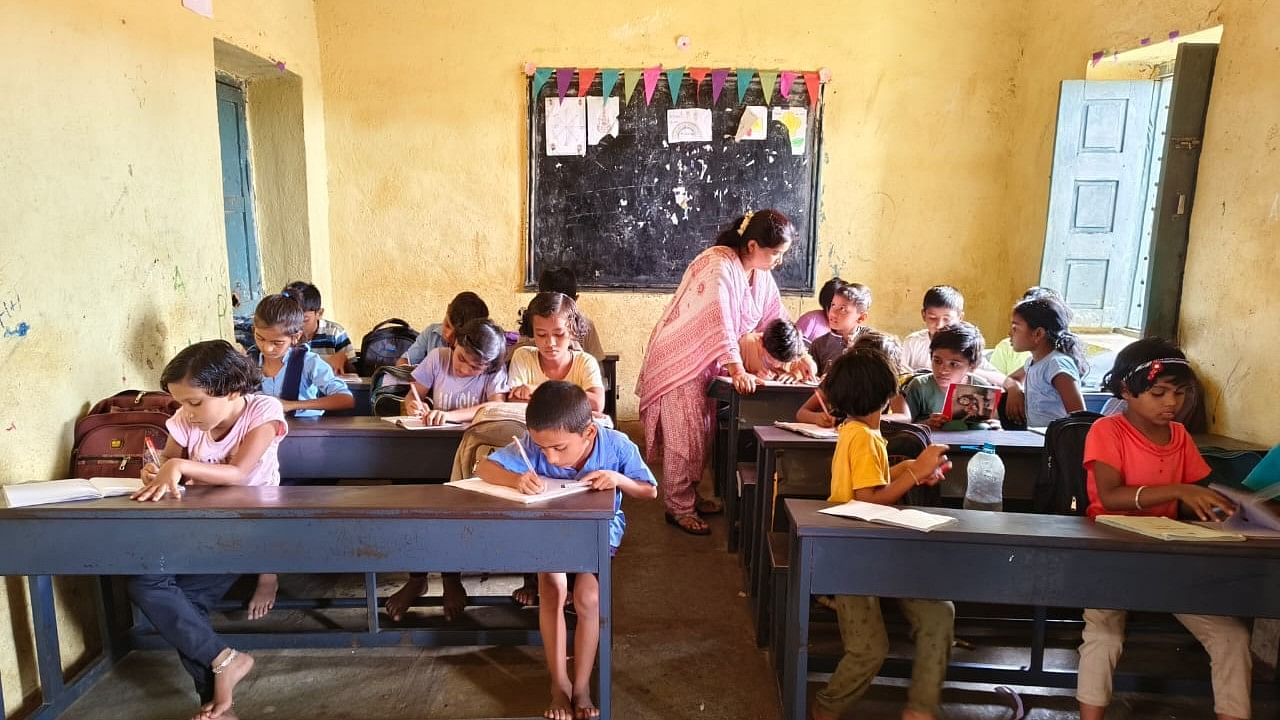
Students learning at the government school in the Lambani thanda.
Credit: Vittal Shastri
Development work and basic infrastructure are yet to make their way to the tiny hamlet of Gangunaik, a thanda in Shahpur taluk. The village, home to 75 families and a population of around 500, has not seen bus services or paved roads. Still, the Lambani thanda currently has nine students studying MBBS, two students pursuing veterinary degrees and eight police department joinees. Some are working as accountants, forest personnel or first division clerks in various government departments.
For years, the thanda remained isolated from the outside world. The villagers mostly engaged in farming activities to sustain their livelihoods in their small chunks of agricultural land. However, change began when parents in the village started to prioritise their children’s education. Over the past decade, an educational revolution began in the thanda.
The chain reaction began in the year 2000, when Suresh Rathod, a 50-year-old bus conductor with Kalyana Karnataka Road Transport Corporation, left his job to concentrate on his children’s studies.
Inspired by the example of Suresh Rathod and his children, other families have begun preparing their children for higher studies.
“I could not pursue higher education after completing PUC due to acute poverty, but I hoped that my children would be able to,” says Suresh.
“I had lost touch with my family as I was away for several days at a stretch for work. I was not able to focus on my children’s education. Due to this, I resigned to provide them with a quality education,” says Suresh. He used to earn a meagre salary of Rs 1,050 per month, which could not adequately support the education of his daughter and four sons. He started focusing on agriculture on his small landholding, and began to use these earnings to fund his children’s education. His wife Seethabai contributed to the household by working as a daily wage labourer.
Their four sons managed to get admission in a Morarji Desai Residential School (Navodaya) after completing class five in the government school in the thanda.
Now, two of their sons are studying MBBS and the other two are pursuing degrees in veterinary science. Their daughter has a Bachelor of Ayurvedic Medicine and Surgery (BAMS) degree.
The family has served as a source of inspiration to relatives and the larger Banjara community. Several students have begun preparations to get admission in Morarji Desai Residential Schools after completion of lower primary school. These educational institutions were started by the Karnataka government for students from SC, ST, OBC and other minority communities.
Now, some students from the village are even preparing for higher education after graduation. Another young person from the village, 26-year-old Dr Ramesh Rathod has been taking special classes in Dharwad to pursue his postgraduate qualification after completing MBBS. His father, who is a farmer and construction labourer, could not afford the expenditure of his higher studies. Therefore, the student saved over Rs 2 lakh from his salary during his one-year rural service.
“My father enrolled me in coaching classes to get admission into Navodaya while I was studying primary education. His support has helped me to complete a medical degree,” says Dr Ramesh.
The family had to borrow from moneylenders to fund his PU education. But they persevered, and he managed to get a medical seat in the government quota.
The amendment of Article 371J in 2013, which provided 80 per cent reservation in education and employment for locals in Kalyana Karnataka has also helped the Banjara community a great deal.
Problems persist
The lower primary government school in the village has been burdened by various problems. The dilapidated school, which was built several decades ago, has leaky roofs, and lacks toilets and a playground. The teachers and School Development Monitoring Committee (SDMC) say they could not find an alternative land for the construction of a new building. Officials say there is no provision to allot funds for the purchase of land.
SDMC President Chandru Rathod says that teachers are forced to take classes in the Hanuman temple adjacent to the school in the thanda due to the lack of adequate space. “We need at least Rs 25 lakh to buy land to construct the school. We cannot mobilise so much from the Lambani community to buy alternative land,” he adds.
Yet, there are 83 students studying in this lower primary school in the thanda. “Awareness arose among parents to educate their children in the last decade after few students got admission in government residential schools, despite their struggles with poverty. Now, parents do not allow children to miss school even for one day,” says school headmaster Bhagirathi Kadani.
Credit: Vittal Shastri
“The students have good learning capacity,” says Prakash Rathod, who teaches at the school. Around 50 per cent of those students who pass out from class five, get enrolled in Morarji Desai residential schools, he adds.
But getting to school in the thanda is also difficult, due to the lack of transport services, Prakash explains.
Subpar infrastructure
Some parents themselves take their children to the nearby Gogi village every day to attend classes in the higher primary school. A majority of them walk around 3 km.
The pathetic condition of the muddy road has been proving dangerous, as many have suffered injuries while travelling on their bikes. It has become a herculean task for people to walk a 2.5 km stretch to reach the main road, as their long-pending demand for a bridge has not been fulfilled.
“There has been no official action to construct a bridge, forcing us to take a roundabout route,” says gram panchayat member Chennappa Rathod. He believes the refusal to build a proper road comes from the fact that the thanda is situated adjacent to the Shahpur and Mudabal Branch Irrigation Canal. “But our thanda existed decades before these irrigation canals were built,” he adds.